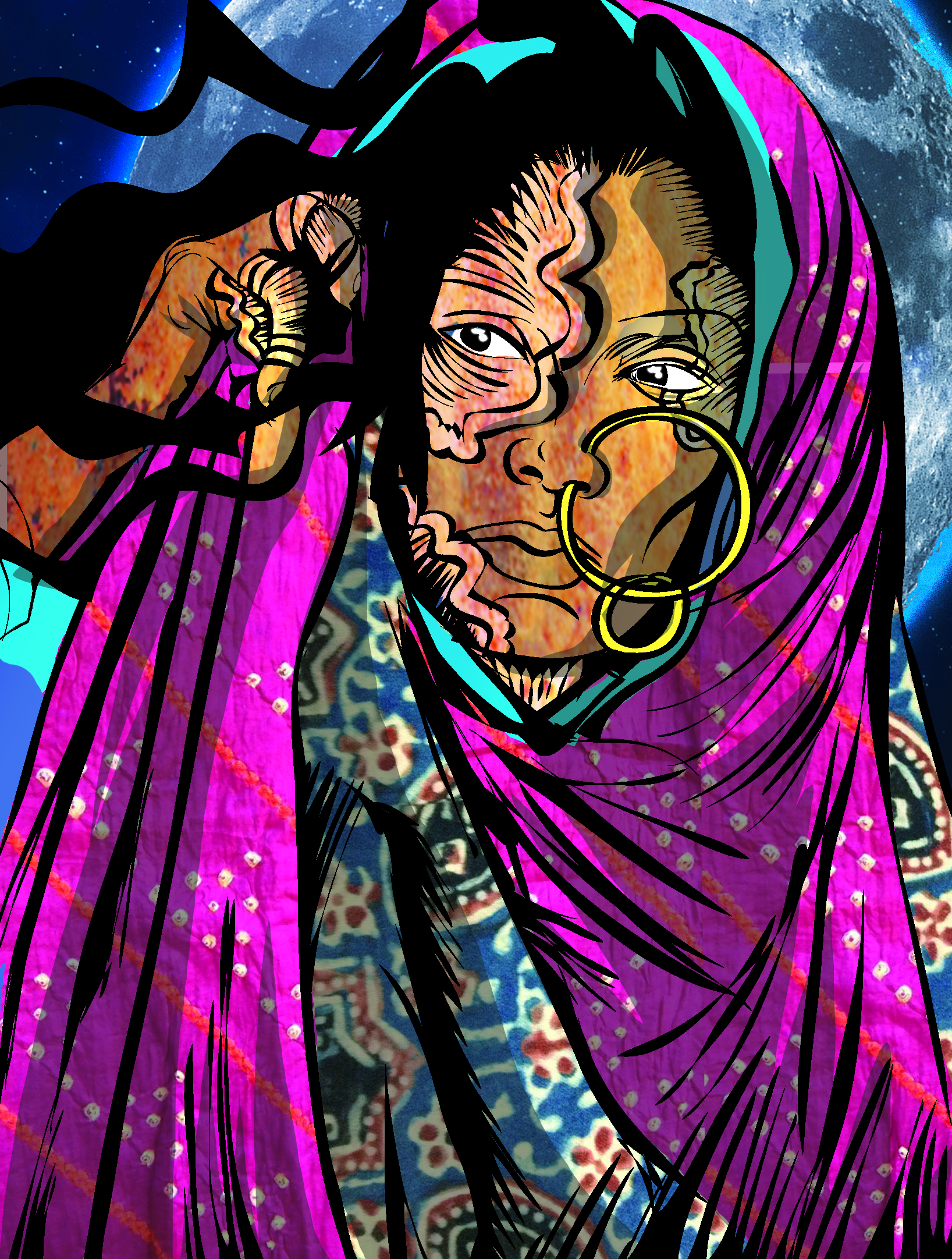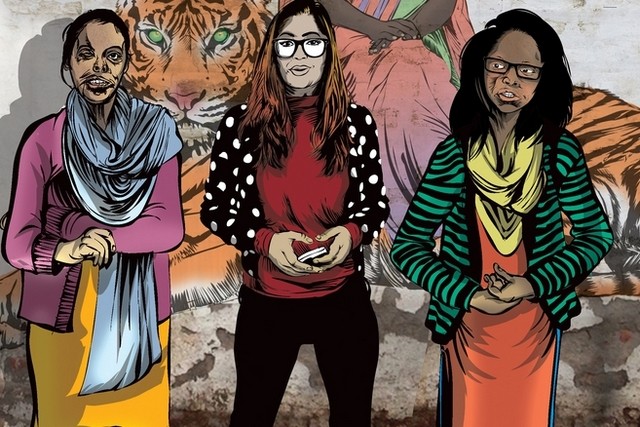In this Award-Winning Comic Book Series, Rape and Acid Attack Survivors are Heroes, not Victims
Priya’s Mirror traces the story of the protagonist, who joins forces with a group of acid attack survivors to fight against the demon-king Ahankar (ego).

The image of Goddess Durga astride a tiger can often be found in homes, offices, shops and temples across India because she is synonymous with feminine power. But this image is being used, perhaps for the first time ever, to highlight the plight of rape victims, survivors of acid attacks, and other women who’ve been affected by gender based violence.
Priya’s Shakti, an immensely popular comic book series featuring the first female Indian superhero and rape victim, uses the image of the ‘goddess astride a tiger’ to show a woman conquering her fears.

Ram Devineni, Paromita Vohra and Dan Goldman created the series in an attempt to raise awareness and initiate conversations about survivors of violent attacks.
Ram, who is based in New York, was in Delhi when the horrific gang rape of Nirbhaya took place on a bus in 2012. This incident received unprecedented media coverage due to the large number of protests happening in response to the government’s indifference towards gender based violence. Ram was involved in these protests too and, one day, he approached a police officer for his opinion on what happened in the bus. According to Ram,
“The officer’s response was ‘no good girl walks home at night,’ implying that she probably deserved it or at least provoked the attack. I knew then that the problem of sexual violence in India was not a legal issue; rather it was a cultural problem. A cultural shift had to happen, especially towards the role of women in modern society. Deep-rooted patriarchal views needed to be challenged.”
Around the same time, Ram started researching Hindu mythology. He observed that when disciples got into trouble, they would call upon their favourite gods for help. He says,
“I began formulating a new mythological tale where a mortal woman and rape survivor, named Priya, seeks help from Goddess Parvati, only after she had nowhere else to turn. Parvati manifests herself in Priya. Although Lord Shiva and other gods do get involved, eventually it is up to Priya to challenge people’s perceptions. I wanted to create a new Indian superhero, a rape survivor who can, through the power of persuasion, motivate people to change.”

Subsequently, he started travelling around India and Southeast Asia to approach poets, philosophers, activists, and sociologists working on issues related to gender-based violence. After conversing with several rape survivors, he realized how difficult it was for them to seek justice and how much their lives were constantly under threat after they reported the crime. He says,
“Their family, local community, and even the police discouraged them from pursuing criminal action against their attackers. The burden of shame was placed on the victim and not on the perpetrators. This created a level of impunity among men to commit more rapes.”
Ram knew he had to use a format that was easily understood by audiences across the world. He cites numerous Amar Chitra Katha comic books as his inspiration to create the Priya series because he feels they were so influential that they “entered the collective consciousness of contemporary Indian culture.” He adds,
“Often, I first learned about Hindu mythology through comic books…Now, comic books have entered the commercial mainstream. Every summer, Hollywood releases big budget blockbuster films based on comic book characters, to enormous box office returns. Comic book characters like Superman, Batman, and Wonder Woman have become modern mythological icons, and other comic books stories, such as Art Spiegelman’s ‘Maus’, address important historical events. We are using existing constructs that are familiar to everyone in India, but presenting them in a fresh and original way.”
But the Priya series is unique in the way it uses modern technology to create a completely immersive experience for the reader. Ram says he always wanted to create an interactive component in the comic book and he was inspired by Michelangelo’s art in the Sistine Chapel to do so. He says,
“Each fresco panel told a distinct story, and together they illuminated a great and divine experience. I wanted to go deeper into each painting but was limited by the periphery of my senses. That’s when the idea of using augmented reality technology came to me as a way to experience the real world without being removed from it. Augmented reality is a major part of our comic book, and by scanning the comic book with the augmented reality app Blippar, you can view animation, real-life stories, and other interactive elements that pop out of the pages.”
Paromoita Vohra, a feminist writer and filmmaker, who is also the founder of Agents of Ishq (a sex positive website), advised Ram and Dan Goldman on Priya’s Shakti. Ram was so impressed with her insight into deep rooted prejudices and how they shape our reactions to certain types of crimes that he decided to get her on board as the writer for the second book – Priya’s Mirror.
The first book turned out to be immensely successful – it was honoured by UN Women as a “gender equality champion” and saw up to 5,00,000 downloads. Following this, the team released Priya’s Mirror, which was funded by the World Bank’s WEvolve initiative. WEvolve aims at changing “attitudes and behaviours that lead to gender inequities, including gender violence.”
Priya’s Mirror traces the story of the protagonist, who joins forces with a group of acid attack survivors to fight against the demon-king Ahankar (ego).

The idea of using acid attack survivors to propagate messages of body positivity and confidence, struck Ram when he met Sonia and Laxmi, two acid attack survivors at their Stop Acid Attacks office.
He says, “What I discovered after talking with them is that they faced the same cultural stigmas and reactions from society that rape survivors had to endure. How society treated them intensified the problem and their recovery. How they were treated by their family, neighbours and society determined what they did next. Often, they were treated like the villains and the blame was put on them. Our comic book focuses on this and tries to change people’s perceptions of these heroic women.”
One of the most interesting tropes used in Priya’s Mirror is the ‘Mirror of Love.’ Priya holds the mirror up to the acid attack survivors and tells them that there is more to them than scars that were inflicted upon them by bitter men.
In the book Priya says, “Why should we hide our wounds? And why should we hide because of our wounds, sisters? Someone reduced you to only your face. But you are other things too. Look into this mirror and you will see.”
Ram recently flew to India to attend the Mumbai Comic-Con, where he and Dan Goldman, the artist, spoke about Priya’s Mirror. Since Priya’s Shakti is the second book in a five-part series, what can we expect from the next book? Ram says, “The next chapter, ‘Priya and the Lost Girls’, is about sex trafficking. We are working with Apne Aap Women Worldwide (a grassroots movement to end sex trafficking) to develop the story. Dan Goldman and I were in Kolkata a few days ago and interviewed exploited women in the red light areas. The story will be co-written with Emmy award winner and advocate and founder of Apne Aap – Ruchira Gupta. The research is funded by the Jerome Foundation and we hope to release it in a year.”
Read Priya’s Mirror, here.
Like this story? Or have something to share? Write to us: [email protected], or connect with us on Facebook and Twitter.
NEW: Click here to get positive news on Whatsapp!

Similar Story

Kyani to Nirula’s: Artist Takes India Down Memory Lane with Sketches of Iconic Eateries
Aditya Raj from Jaipur visited an exhibition during his law school days and decided he would be an artist. Here’s his visual representation of a nostalgia trip with pictures of the most iconic eateries in India.
Read more >
If you found our stories insightful, informative, or even just enjoyable, we invite you to consider making a voluntary payment to support the work we do at The Better India. Your contribution helps us continue producing quality content that educates, inspires, and drives positive change.
Choose one of the payment options below for your contribution-
By paying for the stories you value, you directly contribute to sustaining our efforts focused on making a difference in the world. Together, let's ensure that impactful stories continue to be told and shared, enriching lives and communities alike.
Thank you for your support. Here are some frequently asked questions you might find helpful to know why you are contributing?


This story made me
-
97
-
121
-
89
-
167












